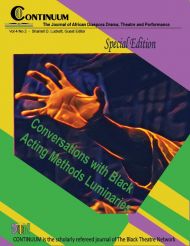The Cambridge Companion to African American Theatre. Edited by Harvey Young,
New York and London: Cambridge University Press, 2013.
This is a powerful teaching tool for exploring African American performance and interrogating the social construction of race in America. There are reoccurring issues in many of the chapters which can help students understand the impact of race on African American theatre. Preceding the volume's introduction is a chronological history, beginning with the first enslaved Africans’ arrival in America through 2012, when Audra McDonald won a Tony Award for Best Actress in Suzan-Lori Parks' adaptation of Porgy and Bess. This sets the context for the book and the history it encompasses. The volume's opening chapters focus on the impact of slavery on performance. They include "Slavery, Performance, and the Design of African American Theatre" by Douglas A. Jones, Jr., and "Slave Rebellions on the National Stage" by Heather S. Nathans. The volume concludes with Harry J. Elam Jr.'s reflections on contemporary black theatre in an essay titled "Black Theatre in the Age of Obama." Each chapter brings up the challenges and the successes of staging African American performance.
Harvey Young begins his introduction with comments about August Wilson's controversial keynote address at the Theatre Communications Group's 1996 biennial event, which brought about a much needed conversation about the production of African American theatre. This collection explores the impact of history on African American theatre and lays a foundation for the many insights, challenges, and questions that Wilson's address brought up, for example, in what way is American culture responsible for the difficulties of producing African American theatre? What is the impact of having non-African Americans producing African American theatre? Since Wilson gave his speech, there have been significant achievements in African American theatre, but the question remains, where do we go from here?
There is a heavy emphasis in The Cambridge Companion to African American Theatre on the staging of African American performances which complements critiques of the numerous plays mentioned in this book. Most of these essays can be read alongside plays such as Lorraine Hansberry's A Raisin in the Sun, Lynn Nottage's Ruined, Adrienne Kennedy's Funnyhouse of a Negro, Douglas Turner Ward's Day of Absence, Suzan-Lori Parks' Topdog/Underdog, and Lydia Diamond's adaptation ofToni Morrison's novel The Bluest Eye.
This companion also considers the significance of Black producing arts institutions while exploring the question, "what is black arts?" A more pertinent question is "should art have a political agenda?" This is a reoccurring question for all the authors, but a few chapters focus specifically on it, including Jonathan Shandell's "The Negro Little Theatre Movement," Aimee Zygmonski's chapter titled "Amiri Baraka and the Black Arts Movement," Heather S. Nathans' "Slave Rebellions on the National Stage," Samuel O'connell's "Fragmented Musicals and 1970s Soul Aesthetic," and Monica White Ndounou's "Early Black Americans on Broadway."
Ndounou reminds us of the significant impact George Walker and Bert Williams, the most famous black minstrels during their time, had on African American performance. Walker and Williams' performances allowed other African American performers to pursue their dreams on stage while constructing their own versions of blackness. Soyica Diggs Colbert's essay, "Drama in the Harlem Renaissance" and "African American Women Dramatists, 1930-1960" by Adrienne Macki Bracon describe the impact of writing drama that focuses on the complexities of African American culture and daily life. Bracon also lays the foundation for further study of African American women playwrights to demonstrate how they have paved the way for each other. The women playwrights they discuss focus on social status, gender, and racism in their works, which allows us to see the impact of Sandra Shannon's chapter, "Women Playwrights who Cross Cultural Borders." Shannon also discusses African American playwrights as "agents of change." Their work has a far-reaching impact and influence outside of American culture. It has a global impact.
What is most telling in this volume is the social construction of blackness as seen through the lens of whiteness in African American drama. Faedra Chatard Carpenter's "Spectacles of Whiteness from Adrienne Kennedy to Suzan Lori-Parks" provides insights into whiteness in African American drama and reflects on its powerful commentary on race. Carpenter also briefly reflects on the construction and history of minstrelsy and interrogates the social and political constructions and perceptions of race in late twentieth century African American performance and society. Nadine George-Graves chapter, "African American Performance and Community Engagement" and Sandra Richard's essay, "African Diaspora Drama" highlight the African retentions in African American performance and within the community. This is refreshing because it emphasizes that African American theatre is grounded in cultural norms other than those informed by slavery.
Each of the chapters in this book prove that there is still much to be debated and discussed about the staging of African American theatre. Harry Elam writes in his essay that " . . . the space and places for new black work remain limited. The mechanisms of production, the control over the venues, budgets, and artistic selections are for the most part not in black hands" (276). The Cambridge Companion to African American Theatre is a much needed critique of the history of African American theatre, which includes 21st century productions. It re-introduces us to a much needed conversation about African American theatre that August Wilson's address brought to the forefront in the late 20th century. Hopefully, this book will inspire more artists and scholars to contribute to an ongoing discussion about African American theatre generally and the impact of culture in the production of African American theatre.
Shondrika Moss-Bouldin
Assistant Professor of Global Diversity: Acting and Directing at Michigan State University.



